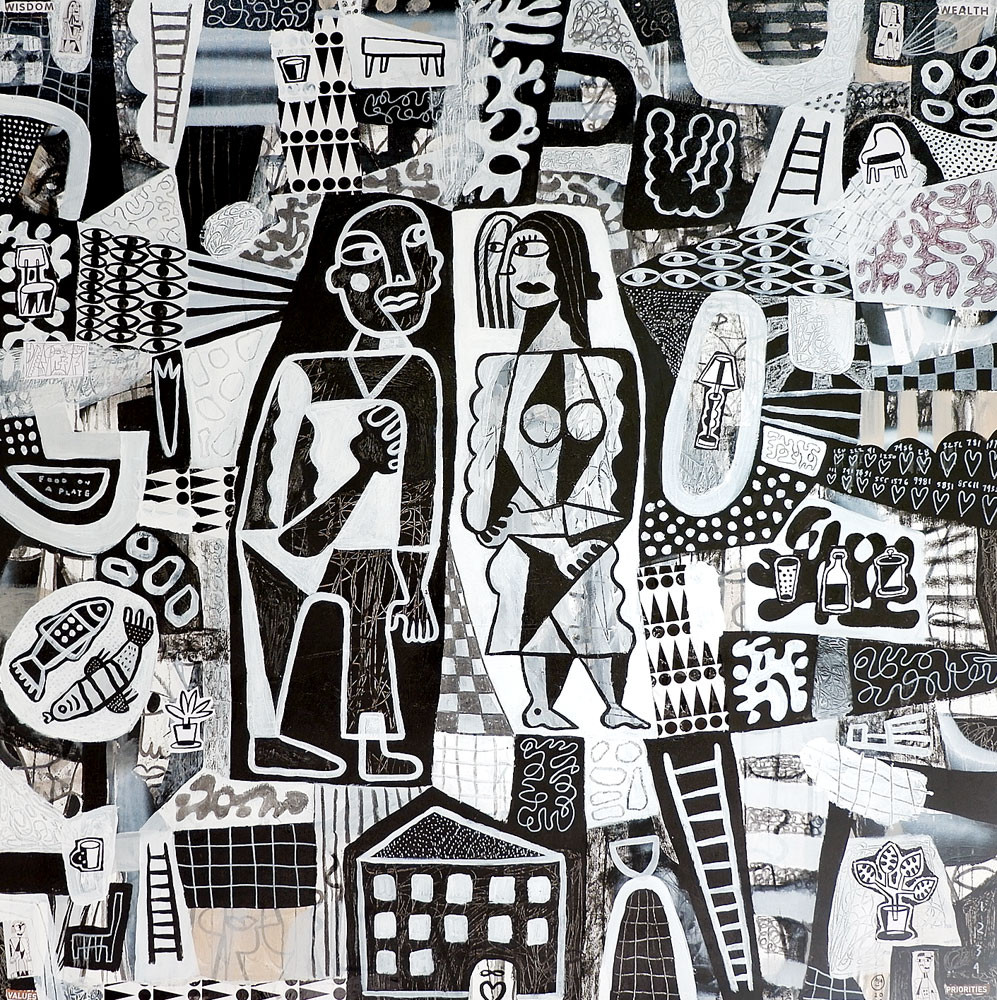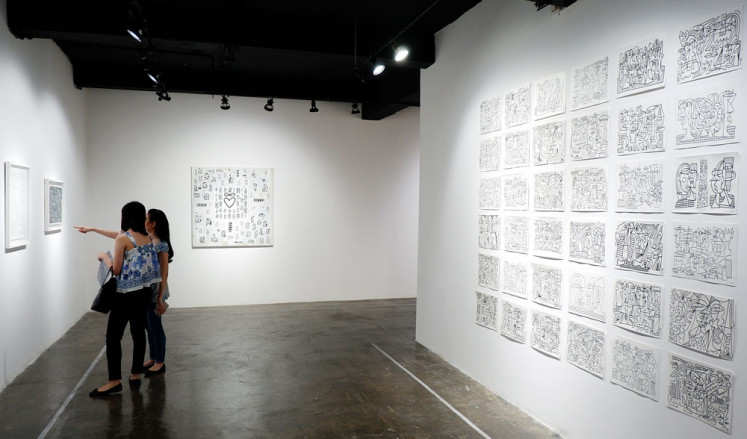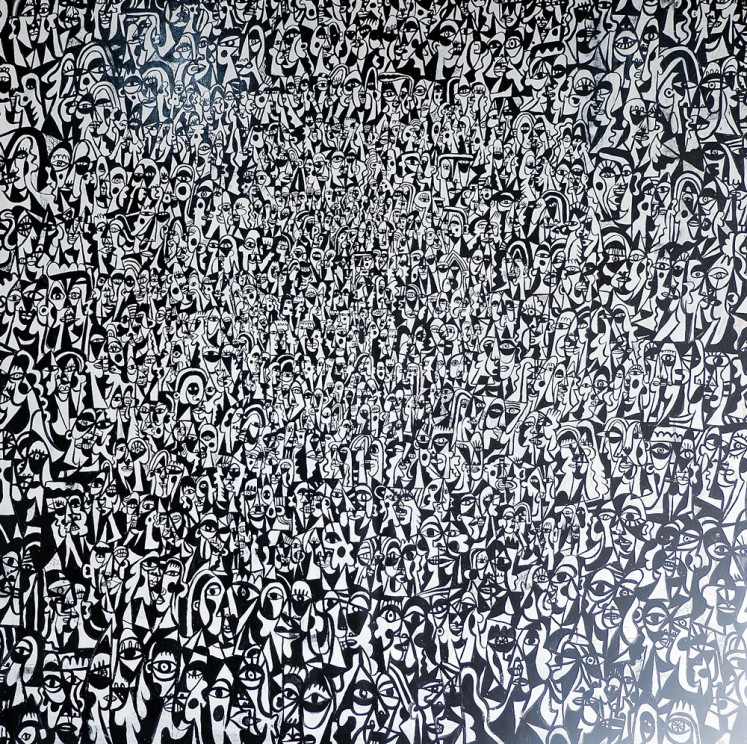Popular Reads
Top Results
Can't find what you're looking for?
View all search resultsPopular Reads
Top Results
Can't find what you're looking for?
View all search resultsAbenk Alter captures duality in black-and-white
Painter Abenk Alter wants to reveal his true self in his first solo painting exhibition, showcasing unique pieces that are very different from his earlier works.
Change text size
Gift Premium Articles
to Anyone
H
usband and wife, light and dark, sky and earth are a few examples of the duality that draws Abenk’s attention. They are complementary, interconnected and interdependent.
Duality also existed in individuals, he said.
For example, ego is the opposite of conscience. To distinguish them is difficult, because what is believed to be one’s inner voice could actually be one’s ego.
“It is not about which side we tend to choose, but about how we can balance the two so that we can discover a reality that is greater than the duality,” said Abenk.
Abenk has called his first solo painting exhibition “Interplay” to reflect the effect that the two sides of a duality have on each other. The exhibition, curated by Mia Maria, features 19 black-and-white paintings through Jan. 27 at RUCI Art Space in South Jakarta.
“I used black and white to visualize the duality,” said the 33-year-old Jakartan, who is a big fan of internationally acclaimed painter Eddie Hara.
Contrasts and similarities: Two visitors view Abenk Alter's works in his first solo exhibition, at RUCI Art Space in South Jakarta. (-/A. Kurniawan Ulung)Everyday Battle is Abenk’s response to the duality he has observed in the heated rivalry between the presidential campaign teams for incumbent Joko “Jokowi” Widodo and opposition candidate Prabowo Subianto.
Read also: Outlook: 2019 offers chance for healthier Jokowi-Prabowo rivalry
“They push us to choose whether to follow our hearts or logic when we cast our votes,” Abenk said.
In Ben & Jody, Abenk explores the duality between happy-go-lucky barista Ben and thinker Jody, the two protagonists in the critically acclaimed feature film, Filosofi Kopi (Coffee Philosophy).
“Ben’s character is totally different than Jody’s, but after they accept each other, they are able to set up an incredible business entity, the Filosofi Kopi cafe,” he said.
The idea to illustrate the Ben-Jody duality came to mind when Abenk was painting a mural at the Filosofi Kopi coffee shop in Blok M, South Jakarta.
Coincidentia Oppositorum by Abenk Alter (-/A. Kurniawan Ulung)In What i Think/What i Feel and Me/You, Abenk illustrates duality in domestic life. He believes that two loving individuals will find greater happiness if they can achieve mutual understanding, even if they have different personalities or hail from different tribes, races and religions.
Abenk studies about duality in 2011 during his master’s program in mysticism at Paramadina University’s Islamic College for Advanced Studies.
“It is fine that people relate mysticism to ghosts and genies, but it actually goes beyond that. What I learned was the phenomenon of mysticism in Islam and Sufism,” he said.
Sufism influenced how he understood life, he said, adding that spiritualism had a connection to his art. Many Sufis and Sufi philosophers were also artists who wrote poems, created dance pieces and produced calligraphic illustrations. For example, the 13th-century Persian Islamic scholar, theologian and Sufi mystic Rumi was known for his poetry.
Abenk is not a new name on the Indonesian arts scene, who was formerly the vocalist of R&B groove band Soulvibe. He left the group in 2014 after nine years to focus on his painting career.
“I no longer have a specific ambition in music,” he said.
Abenk is generally known for his colorful, eye-catching paintings. Since 2013, he has shown them in over 15 group exhibitions and national arts events, from the Jakarta Biennale to Art Jakarta.
He does not mind if his works in “Interplay” are considered “too simple” for being black-and-white. The paintings represent who he truly is, much more so than his colorful works.
Abenk says he produces black-and-white drawings every day in small notebooks, but he had never showed them in the earlier group exhibitions.
“I did not show the black-and-white paintings because I underestimated them. I thought that they were not valid works of art. In my mind, only the colorful ones were valie,” he explained.
He said that he felt content when producing black-and-white drawings, because he did not think about which colors to use or whether people would like it. His purpose was simply to express his feelings, instead of impressing others.
“This exhibition is like presenting my naked self,” he said. “I have no desire to be different or unique. I just want to be myself. I want people to know me the way I am.”













